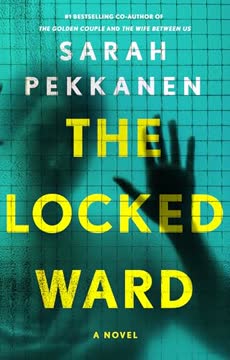Plot Summary
The Silver Man Arrives
A charismatic stranger, Nick Radcliffe, enters the lives of the Swann family shortly after the tragic, senseless death of their patriarch, Paddy Swann. The family is reeling: Paddy was pushed under a train by a stranger, leaving his wife Nina, daughter Ash, and son Arlo devastated. As they gather to mourn, Nick's condolence card and later, his presence, seem like a gentle balm—he claims to have known Paddy in his youth. But beneath the surface, Nick's arrival is the first ripple in a series of deceptions that will upend many lives.
Grief and Family Fractures
The Swanns struggle to process Paddy's death. Ash, in her mid-twenties, is adrift—her career and relationships stalled, her sense of self shaken. Nina, now a widow, is overwhelmed by the responsibilities of running Paddy's restaurant business and holding the family together. The family's grief is complicated by their individual struggles: Ash's mental health history, Arlo's distance, and Nina's exhaustion. Into this fragile space, Nick's attention and empathy seem like a lifeline, especially for Nina, who is both wary and drawn to the possibility of new companionship.
The Condolence Stranger
Nick Radcliffe's story is full of holes, but his warmth and apparent understanding of grief make him welcome. He sends thoughtful gifts—a Zippo lighter, a box of soaps—each with a story connecting him to Paddy. Ash, ever the skeptic, notices inconsistencies: Nick's stories about his past, his career, and his relationships don't quite add up. Yet, as he becomes more involved with Nina, even spending weekends at the Swann home, his presence begins to feel normal, even necessary.
Shadows of the Past
Interspersed with the present-day narrative are glimpses into Nick's (real name: Simon Smith) past. We see him with previous wives and lovers—Amanda, Laura, Tara, Martha—each relationship following a similar arc: intense charm, rapid intimacy, financial entanglement, and eventual abandonment or worse. Simon is a master of reinvention, using aliases and fabricated backstories to worm his way into women's lives, always seeking the next opportunity, always leaving destruction behind.
The Perfect Husband Illusion
Simon's current life is a juggling act. He is "Nick" to Nina, "Alistair" to Martha (his wife in another town, with whom he has a young daughter), and has other identities in his wake. He expertly gaslights, manipulates, and extracts money from his partners, all while maintaining the facade of the perfect, attentive man. His ability to mirror each woman's desires and vulnerabilities is his greatest weapon—and their greatest danger.
Gifts, Lies, and Traces
Ash's suspicions grow as she investigates Nick's background. The box of soaps he gifts her is traced to a local shop, not the Mayfair boutique he claims. A wedding ring found in Nina's bedroom doesn't fit his story. Receipts, pacifier clips, and dog bags hint at other lives. Meanwhile, Martha, overwhelmed by her own struggles and Alistair's (Simon's) absences, begins to notice financial discrepancies and emotional distance, but is slow to connect the dots.
New Love, Old Wounds
Nina, longing for a second chance at happiness, is swept up in Nick's attention. Ash, haunted by her own mental health crisis and the loss of her father, is desperate to protect her mother from further harm. Their relationship strains under the weight of secrets and the intrusion of Nick's presence. When Ash enlists the help of Jane Trevally, her father's legendary ex, the investigation into Nick's true identity accelerates.
The Many Faces of Al
Simon's duplicity is exposed as Ash and Jane connect with other women from his past. Each has a story of being charmed, used, and discarded. Some, like Laura and Amanda, were left in debt and confusion; others, like Tara, simply vanished. The women begin to share information, piecing together Simon's pattern of abuse and manipulation. Meanwhile, Simon, sensing the walls closing in, becomes increasingly desperate and dangerous.
The Web of Women
Through social media and determined sleuthing, Ash, Jane, Nina, Martha, and others form a coalition. They discover Simon's real name, his history of fraud, and his suspected involvement in the disappearance (and possible murder) of previous wives. The group's collective action is a turning point: they are no longer isolated victims but a force seeking justice.
The Soapbox Clue
The pink soapbox, a seemingly innocuous gift, becomes the key to linking Simon's various identities. Ash traces its origin to Martha's flower shop, confirming that "Nick" and "Alistair" are the same man. This discovery, combined with financial records, testimonies, and Simon's own carelessness, provides the evidence needed to confront him.
Unraveling the Impostor
The women lure Simon to Bangate Cove under the pretense of a business opportunity. There, he is confronted by his victims—wives, children, and those he has stalked or defrauded. The reckoning is public and brutal: Simon's lies are exposed, his real name revealed, and his crimes cataloged. He lashes out, physically and verbally, but is overpowered and flees toward the sea.
The Trap at Bangate Cove
Simon, cornered and desperate, runs into the freezing sea, pursued by his sons. He disappears beneath the waves, presumed drowned. The women and their families are left on the shore, processing the trauma and the relief of his apparent demise. The police are called, but Simon's body is never recovered, leaving a lingering uncertainty.
Reckoning on the Beach
The aftermath is a mix of triumph and sorrow. The women share their stories, support each other, and begin the slow work of healing. Some, like Ash and Nina, find new strength in their bond; others, like Martha, are left to rebuild from the ruins of their trust. The group's collective action has brought an end to Simon's reign of terror, but the scars remain.
The Vanishing
Though presumed dead, Simon's ultimate fate is left ambiguous. In a chilling epilogue, it's revealed that Amanda, his first wife, is alive and complicit in his crimes. She awaits his return in the Algarve, suggesting that the cycle of manipulation and abuse may not be over. The story ends with the unsettling possibility that Simon (or men like him) will always find new victims.
Aftermath and Truths
In the wake of Simon's exposure, Ash receives a letter from him, urging her to confront her mother about family secrets. This prompts a cathartic conversation between Ash and Nina, where long-buried truths are finally aired. Both women emerge stronger, ready to move forward with their lives, free from the shadows of both Paddy and Simon.
The Real Victims
The narrative acknowledges the true victims: the women and children left in Simon's wake, the families shattered, the lives derailed. The story is not just about one man's evil, but about the resilience of those he tried to destroy. The women's solidarity and courage are the real triumph.
The Letter's Final Blow
Ash realizes that the letters she received during her mental health crisis—letters she believed were from her boss—were actually from Simon, further evidence of his long-term manipulation and psychological abuse. This revelation reframes her understanding of her own breakdown and recovery, and cements Simon's role as a master predator.
The Cycle Continues
The story closes with a warning: men like Simon Smith are real, and their methods are insidious. The women's victory is hard-won, but the threat persists. The final image is of Amanda, waiting for Simon's return, ready to begin the cycle anew.
Characters
Simon Smith / Nick Radcliffe / Alistair Grey
Simon is a sociopathic conman who reinvents himself for each new victim, using charm, empathy, and psychological insight to exploit women emotionally and financially. He is driven by envy, entitlement, and a bottomless need for validation and control. Simon's relationships are transactional; he mirrors his partners' desires, then drains them of resources and self-worth. His lack of remorse, ability to compartmentalize, and escalating violence make him a chilling antagonist. His ultimate downfall is precipitated by his own arrogance and the collective action of his victims.
Nina Swann
Nina is Paddy's widow, left to manage his restaurant legacy and her fractured family. Intelligent, resilient, and emotionally complex, she is both vulnerable to Simon's attentions and ultimately strong enough to face the truth. Her journey is one of moving from grief and self-doubt to agency and solidarity with other women. Her relationship with Ash is central, evolving from tension to mutual respect and honesty.
Ash (Aisling) Swann
Ash is a young woman struggling with mental health challenges, the loss of her father, and a stalled adulthood. Her skepticism and tenacity drive the investigation into Simon's true identity. Ash's arc is one of self-discovery and empowerment: she moves from self-doubt and isolation to leadership and connection, both with her mother and with other victims. Her psychological insight and willingness to confront painful truths are key to the story's resolution.
Martha
Martha is Simon's current wife in another town, mother to his young daughter Nala. She is hardworking, creative, and loving, but overwhelmed by Simon's absences and financial manipulation. Her journey is one of painful awakening: from denial and self-blame to clarity and action. Martha's willingness to join forces with Nina and Ash is pivotal in bringing Simon down.
Jane Trevally
Jane, Paddy's legendary ex-girlfriend, is initially a figure of myth and suspicion. Her intelligence, resourcefulness, and outsider perspective make her an invaluable ally to Ash. Jane's own history of being misunderstood and dismissed mirrors Ash's, and their partnership is a model of intergenerational female solidarity.
Emma Greenlaw
Emma is the daughter of Tara, one of Simon's missing wives. Hardened by loss and suspicion, she is a key link in the network of victims. Her determination to find the truth about her mother's disappearance is both a source of strength and a reminder of the story's darkest stakes.
Laura Drummond
Laura is another of Simon's ex-wives, left in debt and confusion. Her testimony about Simon's methods and the psychological toll of his abuse is crucial in building the case against him. Laura's resilience and willingness to revisit her trauma for the sake of others exemplify the story's theme of collective healing.
Amanda Law
Amanda is Simon's first wife, believed to be dead or missing. In a final twist, she is revealed to be alive and complicit in Simon's crimes, helping him evade justice and continue his predations. Amanda's character complicates the victim-perpetrator binary, showing how abuse can breed further harm.
Paddy Swann
Paddy's death is the catalyst for the story. In life, he was a larger-than-life figure—charming, flawed, and beloved. His absence leaves a void that Simon exploits. Paddy's legacy is both a source of strength and a burden for his family.
Joe Kritner
Joe is the mentally ill man who pushed Paddy under a train, manipulated by Simon ("the Silver Man") into committing the crime. His story is a tragic illustration of how Simon's evil extends beyond romantic relationships, ensnaring the vulnerable and desperate.
Plot Devices
Multiple Timelines and Perspectives
The novel weaves together present-day events, flashbacks, and multiple first-person perspectives (Ash, Nina, Martha, Simon, and others). This structure allows the reader to see the same events from different angles, gradually assembling the full picture of Simon's crimes and the women's responses. The shifting viewpoints also mirror the theme of unreliable narration and the difficulty of discerning truth from manipulation.
Foreshadowing and Symbolism
Objects like the Zippo lighter, the pink soapbox, and the wedding ring serve as breadcrumbs, linking Simon's various identities and crimes. The recurring motif of gifts—always with a hidden agenda—underscores the theme of deception. The "Silver Man" legend, initially dismissed as delusion, is revealed as a chilling reality, foreshadowing Simon's capacity for orchestrated violence.
Social Media and Collective Action
The creation of the DON'T LET HIM IN Facebook group is a turning point, transforming isolated victims into a coordinated force. The use of online sleuthing, message boards, and digital clues reflects the modern reality of both predation and resistance. The story's climax—a public confrontation organized via social media—demonstrates the power of collective action.
Psychological Manipulation and Gaslighting
Simon's primary weapon is psychological: he gaslights, love-bombs, and isolates his victims, making them doubt their own perceptions and worth. The novel meticulously documents the stages of abuse, from idealization to devaluation to discard, illustrating how even intelligent, capable women can be ensnared.
Open-Ended Resolution
Simon's apparent death in the sea is left unresolved, and the epilogue suggests he may survive to begin the cycle anew. This ambiguity reflects the real-world difficulty of achieving closure in cases of abuse and fraud, and serves as a warning that evil adapts and persists.
Analysis
Lisa Jewell's Don't Let Him In is a masterful psychological thriller that explores the devastating impact of a predatory sociopath on a web of women and families. Through a kaleidoscopic narrative, Jewell dissects the mechanics of manipulation, the vulnerabilities that abusers exploit, and the resilience of those who survive. The novel is both a gripping mystery and a social commentary on the dangers lurking behind charm and empathy. Its structure—shifting perspectives, layered timelines, and interconnected plotlines—mirrors the confusion and fragmentation experienced by victims of abuse. The story's ultimate message is one of vigilance, solidarity, and the necessity of believing women. By foregrounding the collective action of Simon's victims, Jewell offers hope without minimizing trauma, and by leaving the ending open, she reminds us that the fight against coercive control and psychological violence is ongoing. The book is a cautionary tale for the digital age, urging readers to look beyond appearances and to trust their instincts—and each other.
Last updated:
FAQ
Synopsis & Basic Details
What is Don't Let Him In about?
- A grieving family's vulnerability exploited: The novel centers on the Swann family – widow Nina, daughter Ash, and son Arlo – reeling from the sudden, violent death of patriarch Paddy. A charming stranger, Nick Radcliffe, enters their lives claiming a past connection to Paddy, offering comfort but harboring sinister intentions.
- A conman's web of deception: The story follows Nick, whose real name is Simon Smith, as he juggles multiple identities and relationships, preying on vulnerable women like Nina and Martha (his current wife in another town) for emotional and financial gain, leaving a trail of ruined lives and disappearances.
- Victims uniting to expose a predator: As inconsistencies in "Nick's" story mount, Ash, aided by her father's ex Jane Trevally and other women from Simon's past, uncovers his history of fraud, manipulation, and suspected murder, leading to a dramatic confrontation.
Why should I read Don't Let Him In?
- Masterful psychological suspense: Lisa Jewell expertly builds tension through shifting perspectives and timelines, immersing readers in the chilling reality of psychological manipulation and gaslighting, making you question who to trust.
- Compelling character studies: The novel offers deep dives into the emotional complexities of its female characters – their grief, resilience, and capacity for both vulnerability and strength – as they navigate trauma and fight back against their abuser.
- Timely exploration of real-world dangers: Drawing inspiration from real-life conmen (as noted in the acknowledgments), the book serves as a cautionary tale about the insidious nature of predators who hide behind charm and exploit emotional needs, highlighting the importance of vigilance and collective action.
What is the background of Don't Let Him In?
- Inspired by real-life con artists: The author's acknowledgments explicitly state that the character of Simon Smith was brought to life with the help of documentaries, podcasts, and books about "utterly TERRIBLE MEN" who are "psychopaths, monsters, users." This grounds the fictional narrative in real-world predatory behavior.
- Exploration of modern vulnerabilities: The story touches on themes relevant to contemporary life, including the complexities of online dating (how Nina and Tara met Simon), the use of social media for both connection and investigation (the DON'T LET HIM IN Facebook group), and the psychological impact of gaslighting and manipulation.
- Setting reflects emotional states: Locations like the grand but now grief-filled Swann house, Martha's cozy cottage hiding turmoil, and the desolate Bangate Cove where the climax occurs, mirror the characters' internal states and the unfolding drama.
What are the most memorable quotes in Don't Let Him In?
- "Don't let him in.": This phrase, appearing as the book's title and the name of the victims' Facebook group, becomes a powerful, recurring motif representing the central warning and the collective resistance against Simon's insidious intrusion into lives.
- "He lies with passion and self-belief, this man. He lies like a man who has never been caught out in a lie, who thinks he is invulnerable.": Ash's early observation captures the chilling confidence of Simon's manipulation, highlighting his psychological skill and the difficulty victims face in seeing through his facade.
- "You are my priority, Ash. You and your brother. Always have been. Always will be. And I'm sorry if I've made you feel unwelcome in your own home. Unsafe.": Nina's heartfelt apology to Ash near the end signifies a crucial turning point in their relationship, demonstrating the healing power of honesty and reaffirming their unbreakable bond amidst the chaos Simon created.
What writing style, narrative choices, and literary techniques does Lisa Jewell use?
- Shifting first-person perspectives: The narrative frequently changes viewpoint, primarily between Ash, Nina, Martha, and Simon (under various aliases), offering intimate access to their thoughts, feelings, and limited understanding of the unfolding events, creating suspense and revealing Simon's duplicity.
- Interspersed flashbacks and timelines: The story jumps between the present day and Simon's past relationships (labeled by years earlier), gradually revealing his history and patterns of behavior, allowing the reader to piece together the full scope of his manipulation before the characters do.
- Subtle foreshadowing and symbolic objects: Jewell employs recurring motifs like the pink gift boxes, the Zippo lighter, and the wedding ring as breadcrumbs, hinting at connections between Simon's different lives and victims, rewarding attentive readers who spot the subtle clues.
Hidden Details & Subtle Connections
What are some minor details that add significant meaning?
- The recurring pink gift box: The distinctive pink box, first used by Nick to send Paddy's Zippo, reappears as the packaging for the soaps Nick gives Ash for Christmas. Ash later traces this box to Martha's flower shop, providing a crucial link between Nick Radcliffe and Alistair Grey, confirming they are the same person and revealing his lie about the soaps' origin.
- Simon's specific lies about mundane things: Simon's detailed but false claims, like the color of his boots ("They're black. These are gray.") or the presence of a gym at a hotel, are seemingly minor but reveal his compulsive need to control every detail of his narrative and his arrogance in believing he won't be caught, highlighting his pathological deceit.
- The pacifier clip and dog poo bag: Finding these items in Nick's coat pockets, despite his claims of having no children or dog, are early, seemingly insignificant clues that hint at another hidden life (with Martha and Nala), foreshadowing the complexity of his deception long before Ash understands their meaning.
What are some subtle foreshadowing and callbacks?
- The "Silver Man" delusion: Joe Kritner's initial, seemingly nonsensical mention of a "big Silver Man" who told him to push Paddy is dismissed as part of his mental illness. This is a subtle callback to Simon's appearance (tall, white hair) and foreshadows his direct involvement in Paddy's murder, revealing the chilling reality behind the delusion.
- Paddy's "difficult" personality: Nina's later confession about Paddy being a "difficult man to live with," "patronizing," and having a "big ego" subtly foreshadows Simon's specific, vindictive grudge against him, suggesting Simon's motive for orchestrating Paddy's death stemmed from a past humiliation rather than a random act.
- Ash's past stalking accusation: Ash's history of being accused of stalking her boss, Ritchie Lloyd, and her subsequent mental health crisis, is a callback that makes her initially doubt her own suspicions about Nick. It also foreshadows Simon's manipulation, as it's later revealed he sent her the letters she thought were from Ritchie, showing his long-term, insidious psychological abuse.
What are some unexpected character connections?
- Jane Trevally and the victims' network: Paddy's legendary ex-girlfriend, Jane, initially seems like a figure from the past. Her connection to Ash, however, leads her to become a key ally and catalyst in uncovering Simon's web, leveraging her resources and network to help connect Ash with other victims like Laura and Emma.
- The coffee shop waitress, Kadija: The brief, uncomfortable interaction between Simon and Kadija in the Tooting coffee shop, where she accuses him of making her feel unsafe, seems like a minor scene. However, Kadija later appears at the Bangate Cove confrontation, revealing that Simon's predatory behavior extended beyond his romantic targets to seemingly random women he encountered.
- Marcelline's ex-boyfriend, Jason: The seemingly unrelated detail of Marcelline's pink soapbox leading Ash to her ex-boyfriend, Jason Trevor, a farrier, provides an unexpected link to Simon's past movements and potentially another victim (Jason's mother, who may have regifted the soaps), highlighting how Simon's path crossed with seemingly ordinary people in unexpected ways.
Who are the most significant supporting characters?
- Jane Trevally: More than just a supporting character, Jane becomes a co-investigator and mentor for Ash. Her intelligence, resources, and willingness to believe Ash's seemingly outlandish suspicions are crucial in uncovering Simon's history and connecting with other victims.
- Emma Greenlaw: As the daughter of missing wife Tara, Emma represents the devastating, long-term impact of Simon's actions. Her relentless search for her mother and her existing dossier on "Jonathan Truscott" provide vital information and a powerful motivation for the collective action against him.
- Laura Drummond: Laura, one of Simon's abandoned wives, provides crucial testimony about his methods as a life coach, his lies about his family, and the financial ruin he left behind. Her willingness to share her painful story validates Ash's suspicions and helps the other women understand the pattern of his abuse.
Psychological, Emotional, & Relational Analysis
What are some unspoken motivations of the characters?
- Nina's desire for a "Part Two": While grieving Paddy, Nina is drawn to Nick because he makes her feel "like there might be a part two? That my book didn't end?" Her unspoken motivation is a deep-seated need for renewal and a fear of her life being over after Paddy's death, making her vulnerable to Simon's promise of a new beginning.
- Simon's envy of Paddy Swann: Beyond financial gain, Simon harbors a deep, unspoken vindictiveness towards Paddy, stemming from a perceived humiliation decades earlier. His actions, including orchestrating Paddy's murder and attempting to take over his restaurant legacy, are fueled by a petty, lifelong grudge and a need to destroy the man he envied.
- Ash's need for validation of her sanity: Haunted by her past mental health crisis and the stalking accusation, Ash's relentless pursuit of the truth about Nick is driven not just by a desire to protect her mother, but by an unspoken need to prove her own perceptions are accurate and that she is not "going mad again."
What psychological complexities do the characters exhibit?
- Ash's struggle with BPD and perception: Ash's diagnosis of borderline personality disorder adds a layer of complexity to her narrative. Her past experiences lead her to question her own judgment ("I clearly didn't have any idea who she was back then... And now she knows she's not [normal]"), while simultaneously making her uniquely attuned to subtle inconsistencies and emotional manipulation, creating internal conflict and external doubt from others.
- Martha's denial and need for a "good man": Martha exhibits psychological denial, repeatedly rationalizing Alistair's suspicious behavior and absences ("It's the ADHD... It's his stupid job."). Her deep-seated need for a stable, loving partner after a previous divorce and unexpected late-life child makes her overlook glaring red flags, highlighting how emotional needs can override rational thought.
- Simon's compartmentalization and lack of empathy: Simon's ability to maintain completely separate, complex lives with different women and families demonstrates extreme psychological compartmentalization. His internal monologue reveals a chilling lack of empathy, viewing women as transactional objects and justifying his cruelty by blaming them for their own exploitation ("She was stupid. Stupid for love.").
What are the major emotional turning points?
- Nina's decision to meet Nick: Despite her grief, Nina's tentative agreement to meet Nick after his condolence card marks an emotional turning point, signifying her first step towards potentially moving on from Paddy and opening herself up to new connection, however fraught.
- Martha finding the Paddy's receipt: Discovering the receipt for champagne at Paddy's Ramsgate on the night Alistair claimed to be sleeping in a staff room is a major emotional turning point for Martha. It shatters her denial and forces her to confront the possibility of his infidelity and deeper deception, leading her to investigate his finances.
- Ash's conversation with Joe Kritner: Meeting the man who killed her father and showing him Nick's photo is a profoundly emotional turning point for Ash. Joe's recognition of "the Silver Man" validates Ash's suspicions, transforms her grief into a quest for justice, and solidifies her resolve to expose Simon, confirming her sanity and purpose.
How do relationship dynamics evolve?
- Nina and Ash's strained bond to solidarity: Initially, Nina and Ash's relationship is strained by grief, Ash's past issues, and Nina's new relationship with Nick, leading to tension and lack of trust. As they uncover the truth about Simon together, their bond transforms into one of mutual trust, support, and fierce solidarity, becoming a central strength against the chaos.
- Martha's trust in Alistair to betrayal: Martha's relationship with Alistair evolves from deep love and trust, where she sees him as her "perfect man" and relies on him implicitly, to a devastating realization of profound betrayal as she uncovers his lies, financial theft, and multiple identities, leading to her active participation in his downfall.
- Simon's transactional relationships exposed: Simon's relationships with women are revealed to be purely transactional, based on mirroring their needs and extracting resources. The collective action of his victims exposes this pattern, transforming their individual, isolated experiences of manipulation into a shared narrative of abuse and a united front against their abuser.
Interpretation & Debate
Which parts of the story remain ambiguous or open-ended?
- Simon Smith's ultimate fate: Although presumed drowned after running into the sea at Bangate Cove, Simon's body is never recovered. This leaves his death ambiguous, allowing for the possibility, however slim, that he survived and could reappear, reinforcing the theme that predators like him are difficult to truly escape.
- The location of Tara and Amanda's bodies: Despite the police reopening investigations into the disappearances of Tara Truscott and Amanda Law, their bodies are not found by the end of the novel. This leaves their children and loved ones without closure, highlighting the lasting trauma and unresolved questions left by Simon's crimes.
- The full extent of Amanda's complicity: While the epilogue reveals Amanda helped Simon dispose of Tara's body and awaited his return, the depth of her involvement in his other crimes and her motivations for remaining loyal to him are not fully explored, leaving her character and the nature of her relationship with Simon open to interpretation.
What are some debatable, controversial scenes or moments in Don't Let Him In?
- Simon's street stalking: The scenes describing Simon following women on the street, invading their personal space for a "quick, cheap thrill," are controversial due to the predatory nature of the act and Simon's internal justification ("merely invading that woman's personal space because I was annoyed by her energy"), highlighting the disturbing reality of male entitlement and harassment.
- The portrayal of Ash's mental health: Ash's past diagnosis of borderline personality disorder and the stalking accusation could be debated in terms of how it influences her credibility and how her mental health is portrayed in relation to her ability to uncover the truth, raising questions about societal biases against mental illness.
- The victims' decision to confront Simon themselves: The choice by the network of women and family members to lure Simon to Bangate Cove for a private confrontation rather than immediately going to the police could be seen as controversial, raising questions about the ethics and safety of their plan, even if it leads to his apparent demise.
Don't Let Him In Ending Explained: How It Ends & What It Means
- Simon's apparent death and the victims' reckoning: The climax sees Simon lured to Bangate Cove and confronted by a group of his victims, including his wives, children, and those he stalked or defrauded. Exposed and cornered, he flees into the sea and is presumed drowned, though his body is not found. This confrontation serves as a collective reckoning, allowing the victims to voice their experiences and reclaim power.
- Unresolved disappearances and lingering trauma: While Simon is gone, the fates of Tara Truscott and Amanda Law remain unknown, their bodies undiscovered. This emphasizes that even with the abuser removed, the trauma and unanswered questions for the victims' families persist, highlighting the lasting damage of his crimes.
- The cycle of abuse and the possibility of survival: The epilogue reveals Amanda Law is alive and complicit, waiting for Simon in the Algarve, suggesting his potential survival and the continuation of his predatory cycle. This ending means that men like Simon are not easily defeated and serve as a chilling reminder that vigilance is necessary, and the fight against such manipulation is ongoing.
Review Summary
Don't Let Him In is a gripping psychological thriller that has polarized readers. Many praise its tense atmosphere, compelling characters, and unexpected twists, calling it Jewell's best work yet. The story follows multiple women entangled with a manipulative, charming man, exploring themes of deception and vulnerability. While some found it captivating and unputdownable, others criticized the slow build-up, repetitive scenarios, and frustratingly naive female characters. Despite mixed opinions, most agree it's an intense, thought-provoking read that showcases Jewell's storytelling prowess.
The Family Upstairs Series
Similar Books
Download PDF
Download EPUB
.epub digital book format is ideal for reading ebooks on phones, tablets, and e-readers.



















